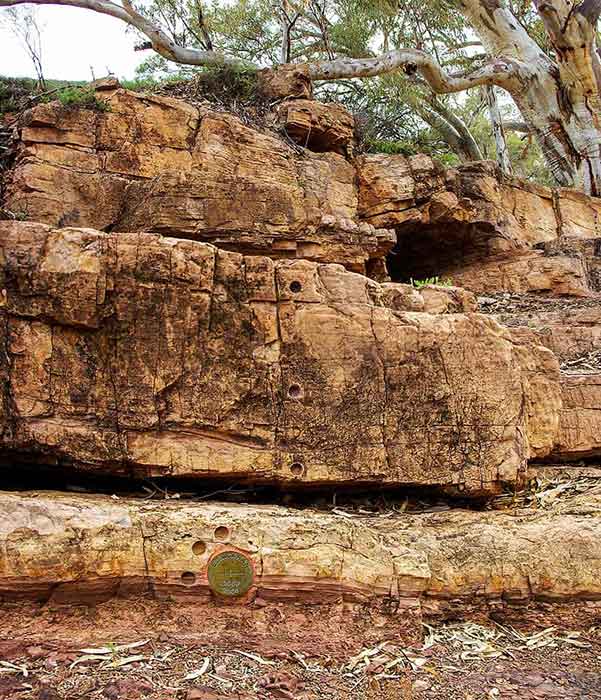
Dicksonia, an Ediacaran fossil (image from Alamy).
Geological Period
Ediacaran
Main geological interest
Paleontology
Stratigraphy and sedimentology
Location
Enorama Creek, South Australia.
31°19’51.6″S, 138°38’06.7″E
Dicksonia, an Ediacaran fossil (image from Alamy).
Iconic and internationally significant Precambrian fossil locality preserving early multicellular life and is namesake of the Ediacaran period.
The Ediacara Hills was the locality where well preserved Precambrian fossils of multicellular life were first found globally (Sprigg, 2007). At this location the Precambrian fossil life forms exhibit diversity (Coutts et al., 2016) with over 20 species of fossils recorded including Parvancorina, Rugoconites, Spriggina, Dickinsonia, Tribrachidium, Kimberella, Charniodiscus and Yorgia. In addition to being the type section for the newly established Ediacaran Period, the Ediacara Hills contains one of the best-exposed and most complete successions of Neoproterozoic to early Paleozoic rocks in the world.
- Geological description
The Ediacara Hills is an iconic and internationally significant fossil locality preserving early (Precambrian) soft-bodied multicellular life (Sprigg, 2007) and is namesake of the Ediacaran period. The area contains a Global Boundary Stratotype Section and Point (GSSP), defined by IUGS International Commission on Stratigraphy (ICS) as an internationally agreed upon reference point on a stratigraphic section which defines the lower boundary of a stage on the geologic time scale – this boundary is marked by a ‘Golden Spike’. The GSSP in the Flinders Ranges, located in Enorama Creek within the Flinders Ranges National Park, was ratified by the ICS in 2004 and pinpoints the lower boundary of the then newly recognised Ediacaran System (Period). The base of the Ediacaran System (Period) is defined by a Golden Spike at the base of the Nuccaleena Formation cap carbonate composed of laminated to well-bedded dolomicrite (Dalgarno and Johnson, 1964) directly above glacial diamictites and associated facies. The new Ediacaran Period encompasses a distinctive interval of Earth history that is bounded both above and below by equally distinctive intervals. The history of this site, fossil studies, and the GSSP selection process for the site are outlined in more detail by Preiss (2005) and Knoll et al. (2006).
- Scientific research and tradition
From their first discovery in 1946 (Sprigg, 2007), Precambrian fossils of this locality have been researched to investigate the origins of Life, the diversity of Life in the Precambrian, and aspects of its palaeoecology. Enorama Creek also is a Global Boundary Stratotype Section and Point (GSSP) ratified in 2004.
- Reference
Brocx, M. (2019) ‘The Role of the International Commission on Stratigraphy (ICS) and the “Golden Spike”’, The Australian Geologist [Preprint].
Coutts, F.J., Gehling, J.G. and García-Bellido, D.C. (2016) ‘How diverse were early animal communities? An example from Ediacara Conservation Park, Flinders Ranges, South Australia’, Alcheringa: An Australasian Journal of Palaeontology, 40(4), pp. 407–421. Available at: https://doi.org/10.1080/03115518.2016.1206326.
Dalgarno, C.R. and Johnson, J.E. (1964) ‘Precambrian rock groups in the Adelaide Geosyncline; a new subdivision – Wilpena Group, Geological Survey of South Australia’, Quarterly Geological Notes, 9, pp. 12–19.
Knoll, A. et al. (2006) ‘The Ediacaran Period: a new addition to the geologic time scale’, Lethaia, 39(1), pp. 13–30. Available at: https://doi.org/10.1080/00241160500409223.
Preiss, W. (2005) ‘Global stratotype for the Ediacaran System and Period — the Golden Spike has been placed in South Australia’, MESA Journal, 37, pp. 20–25.
Sprigg, Reg. (2007) ‘On the 1946 Discovery of the Precambrian Ediacabian Fossil Fauna in South Australia.’, Earth Sciences History, 7(1), pp. 46–51. Available at: https://doi.org/10.17704/eshi.7.1.p13447q2753jr055.
- Author(s)
Margaret Brocx
Adjunct Professor of Research|College of Science, Health, Engineering and Education, Discipline Environmental and Conservation Sciences. Murdoch University, Western Australia, Australia
Vic Semeniuk
Adjunct Professor of Research|College of Science, Health, Engineering and Education, Discipline Environmental and Conservation Sciences. Murdoch University, Western Australia, Australia


